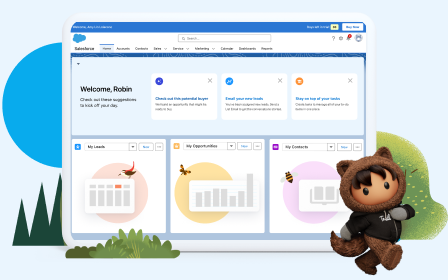Sell as a Team and Split the Credit
Learning Objectives
- Explain when to use opportunity teams and account teams.
- Apply revenue splits and overlay splits to an opportunity.
Sell as a Team
It often takes a team to close a deal. If your Salesforce admin has enabled team selling, adding an opportunity team helps team members work together and track the opportunity’s progress.
Opportunity teams are a bit like account teams. Both let you relate particular people at your company to accounts or opportunities. But, whereas account team members can be expected to form a long-term relationship with a customer, an opportunity team is a temporary group. It’s composed of people who can help you close a deal. Opportunity team members have special visibility into an opportunity, such as related Chatter posts.
If you often work with the same coworkers on your opportunities, create a default opportunity team and automatically add that team to all new opportunities. Default opportunity teams make it easy to set up sales teams for your opportunities. Check out the help and video listed under Resources at the end of this unit for more information about creating and managing opportunity teams.
If you’ve set up a default account team, you can add it to an opportunity instead of an opportunity team.
Split Credit for an Opportunity
Your Salesforce admin can enable opportunity splits to give opportunity team members incentive to complete a deal by letting the opportunity owner share credit.
If you’re the opportunity owner or above the owner in the role hierarchy, you can add and adjust splits on an opportunity.
At the Cloud Nine trade show, you run into a colleague from the Cloud Kicks London office, Robin Singh. Robin introduces you to Carter MacLeod, who runs the UK subsidiary of Get Cloudy Consulting. Carter loved the custom sneakers you sold to Get Cloudy for the San Francisco conference. He wants similar sneakers for employees attending a conference in Europe. You exchange contact info with Carter.
You create an opportunity for the European sneakers. Use the Opportunity Team related list to add Robin Singh to the opportunity team.
Over the next month, Robin works with Carter locally in London and coordinates with your team in San Francisco to make sure that Carter’s experience with Cloud Kicks is good. Along the way, Carter requests a custom logo.
In the Opportunity Splits related list, add splits by clicking Edit Opportunity Splits.
There are two kinds of splits. Revenue splits are for crediting team members who are directly responsible for the revenue on an opportunity. Revenue splits always total 100% of the opportunity amount.
As the opportunity owner, you get 100% of the revenue by default. For this opportunity, adjust your revenue percentage to 20% for managing and finalizing the deal with your relationships at Get Cloudy Consulting. Add a split for Robin and give her 80% of the revenue for managing most of the sales cycle.
Now click the Overlay tab.
An overlay split gives you a way to credit supporting team members. It can total any percentage of the opportunity amount, including a percentage over 100%, and it doesn’t count toward the revenue split on the same opportunity.
To track business the designer helped close, you add the designer as an overlay split with 101% credit. At Cloud Kicks, designers with the most business impact receive an end-of-year bonus.
- Split Opportunities
- Split Opportunities with Products
- Split Opportunities with Products and Schedules
Resources
- Salesforce Help: Set Up a Default Opportunity Team
- Trailhead: Manage Products, Prices, Quotes, and Orders
- Trailhead: Products, Quotes, and Contracts
